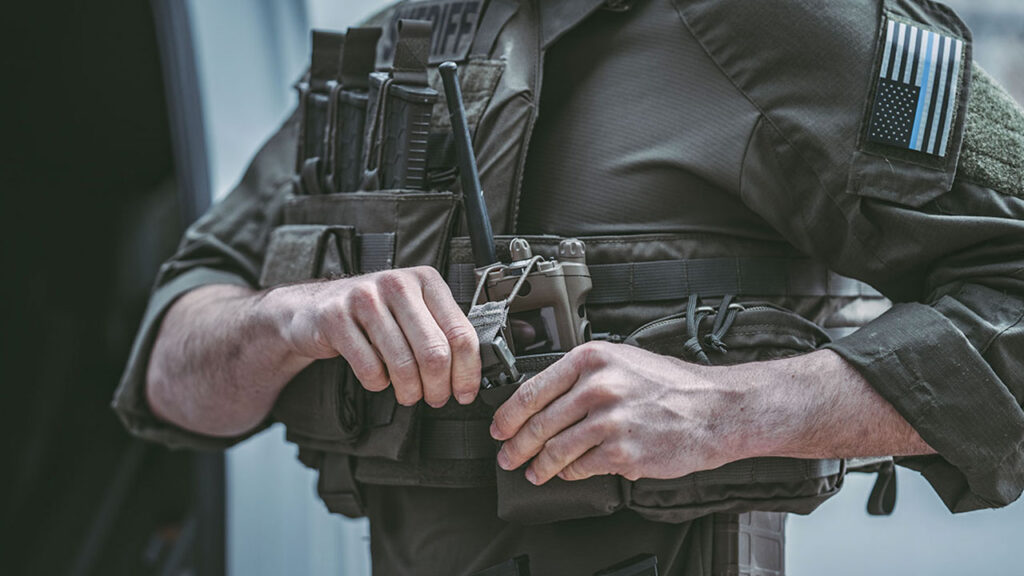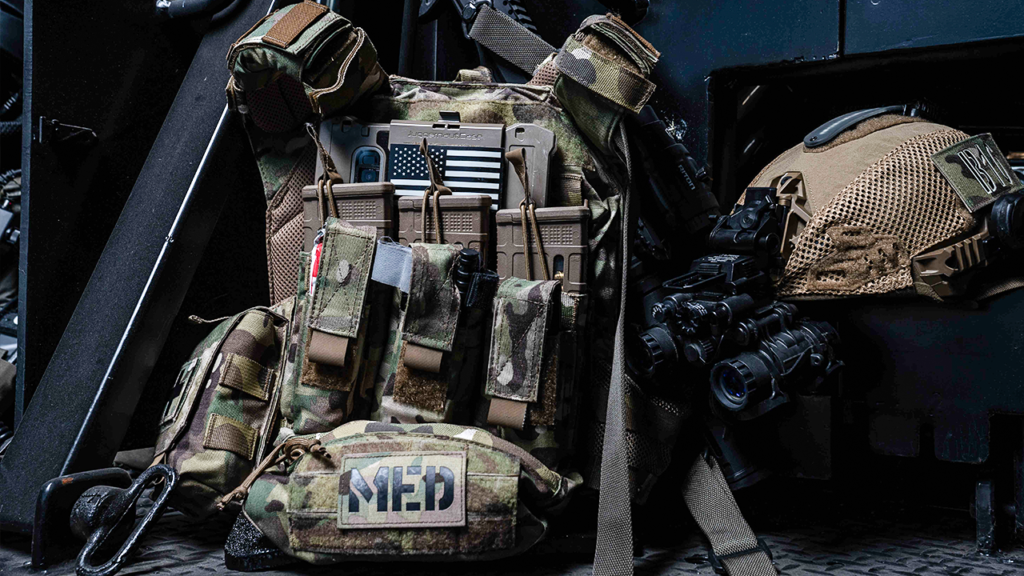How to Choose the Right Plate Carriers

With so many options, how do you pick the right Plate Carrier?
Selecting the right plate carrier is essential for military personnel, law enforcement officers, and civilians who need reliable protection from ballistic threats. Plate carriers are designed to hold armor plates that offer protection against various types of ammunition, and they also provide a platform for attaching tactical gear.
However, finding the perfect plate carrier can be a daunting task due to the multitude of options available on the market. In this comprehensive guide, we will discuss the crucial factors to consider when choosing a plate carrier and provide valuable insights to help you make an informed decision.
What Is A Plate Carrier?
A plate carrier (often called "PC") is a type of bulletproof vest, a key piece of body armor. Due to their multiple functions, plate carriers are commonly used by military and law enforcement personnel and are legal for American citizens. They are also a valuable addition to any civilian's tactical gear.

Uses Of A Plate Carrier
Protection: The primary purpose of a plate carrier is protection. It can resist penetration from ammunition, providing significant defense in combat or shooter situations. While nobody's armor can make you invincible, plate carriers are designed to keep you alive long enough to call for medical aid.
Load Carrying: Plate carriers are also useful for carrying tactical gear. They allow quick access to essential items without digging through a rucksack, crucial in high-stress environments where time is of the essence, such as military operations and law enforcement activities.
Parts Of A Plate Carrier
Plates: A plate carrier includes plates inserted into pockets within a specially designed vest. When inserted correctly on the torso, the plates protect vital organs like the heart, lungs, kidneys, and liver. Without the plates, the vest itself offers minimal protection.
Cummerbund: Most plate carriers have a cummerbund that fits around the waist. This helps adjust the carrier's fit and provides additional attachment points for gear.
Weight Of A Plate Carrier
Plate carriers are heavier than regular Kevlar vests due to the hard armor they are designed to hold. Depending on the type of carrier and the gear loaded, they can weigh between 15 and 35 pounds. Manufacturers continually seek new materials and methods to reduce weight without compromising ballistic resistance.
Materials Of A Plate Carrier
Plates: Plates are typically made from steel, ceramic, polyethylene, or a combination. Each material has its benefits:
- Steel is durable and cost-effective.
- Ceramic is lighter and becoming more common.
- Polyethylene (UHMWPE) is light and can take multiple hits but is more expensive.
Carrier: The carrier is usually made from tough materials like nylon or strong denier polyester, which do not resist bullets but provide a durable platform for the plates.
1. Purpose of the Plate Carrier
The primary consideration when selecting a plate carrier should be its intended use. Are you a tactical operator or law enforcement officer requiring a durable and reliable plate carrier for high-risk operations? Or, are you a recreational shooter or airsoft enthusiast with more basic needs? Understanding your specific requirements will help you narrow down your options and ensure that you select a plate carrier that meets your needs.
For example, tactical operators should prioritize plate carriers designed for high-intensity operations and built to withstand extreme conditions. These carriers typically feature additional pockets, reinforced stitching, and adjustable straps for maximum comfort and protection.
2. Types of Plate Carriers
Plate carriers can be broadly categorized into three main types based on the cut and design:
- Full-cut plate carriers offer maximum coverage and protection, with large front and back panels to hold armor inserts.
- Shooter’s cut plate carriers are smaller and more lightweight, providing adequate protection for most users.
- Swimmer’s cut plate carriers are the lightest and most minimalistic, focusing on mobility and speed.
When choosing a plate carrier type, ensure that it suits your intended usage and provides the necessary balance between protection, weight, and mobility.
3. Sizing and Adjustability
Plate carrier sizing depends on the size of the armor plates you intend to use and your exact chest height measurement . The most common armor plate size is 10×12 inches, which will fit most people’s needs. However, larger 11×14 and smaller 8×10 plates are also available.
When selecting a plate carrier, make sure it can accommodate the size of plates you plan to use . Additionally, the carrier should be adjustable to ensure a snug and comfortable fit. Look for plate carriers with adjustable shoulder straps and cummerbunds that can be customized to fit your body type.
4. Cummerbund Options
The cummerbund is an essential component of chase tactical plate carrier, as it holds the front and back panels together and ensures a secure fit. A good cummerbund should be adjustable and made from durable, lightweight materials like ripstop nylon or Cordura.
Many plate carriers feature cummerbunds with MOLLE webbing for attaching additional gear and may also include internal compartments for side armor plates or magazine pouches. When choosing a plate carrier, ensure that the cummerbund meets your requirements in terms of adjustability and storage options.
5. Weight Considerations
The weight of a plate carrier is an essential factor to consider, as it can significantly impact your mobility and comfort. Plate carriers themselves typically weigh between one to a few pounds, but the addition of armor plates and tactical gear can significantly increase the overall weight.
When selecting a plate carrier, consider the combined weight of the carrier, armor plates, and any additional gear. If mobility is a priority, opt for a lightweight plate carrier that minimizes bulk without compromising protection.

6. MOLLE Webbing and Attachment Options
Most plate carriers come equipped with MOLLE webbing, allowing you to attach various tactical pouches and accessories. MOLLE webbing is available in two styles: classic webbing with loops and laser-cut webbing with pre-cut slots for easy installation and a more streamlined appearance.
When choosing a plate carrier, ensure that it offers sufficient MOLLE webbing to accommodate all your tactical gear and allows for customization based on your specific needs.
7. Plate Carrier Color and Camouflage
The color or camouflage pattern of your plate carrier is an important consideration, as it can affect your visibility in various environments. Plate carriers are available in a wide range of colors, such as black, coyote brown, MultiCam camouflage, and more.
Choose a plate carrier color or camouflage pattern that matches your intended environment and tactical gear. If you are in military service, ensure that your plate carrier conforms to your unit’s regulations and uniform standards.
8. Additional Features
Some plate carriers offer additional features, such as drag handles, loop Velcro panels, and built-in pockets or pouches. Drag handles enable quick extraction of the wearer in emergency situations, while loop Velcro panels allow for the attachment of patches or other items.
When selecting a plate carrier, consider any additional features that may be beneficial for your specific needs and ensure that the carrier includes all necessary components.
9. Price and Budget
The cost of a plate carrier varies depending on the quality, features, and brand. Budget plate carriers can be purchased for under $100, while high-end carriers designed for military or law enforcement use can cost several hundred dollars.
Determine your budget and prioritize the features that are most important to you. Remember that investing in a high-quality plate carrier can provide better protection and durability in the long run.
10. A Brand you can Trust
Here at Chase Tactical, we take our manufacturing process VERY seriously because our product can make the difference between life and death to our customers. We are a premier manufacturer of tactical equipment, including plate carriers.
Our plate carriers are made of high-quality nylon and manufactured with U.S. sourced, Mil-Spec materials designed to endure and outlast any military or law enforcement mission.
A prime example of our many plate carriers offerings is our Modular Enhanced Armor Plate Carrier (MEAC). This carrier is a lightweight modular plate carrier that works with any set of hard armor plates and soft armor backers. It also features a triple magazine front panel secured with hook & loop into the carrier that can fit 3x 30 round 5.56mm magazines.
Features Of A Plate Carrier
A plate carrier is a versatile and essential piece of tactical apparel, offering protection and practicality for military, law enforcement, and civilian use.
Here's a detailed look at its features:
Adjustable Fit and Sizing
One of the primary features of a plate carrier is its adjustable fit, allowing it to accommodate various body types and sizes. You can ensure a proper fit by measuring your torso from the sternum to the belly button and around your waist. Most carriers come with adjustable straps and cummerbunds to provide a secure and comfortable fit, regardless of your body size.
Compatibility with Various Plate Sizes
Plate carriers are designed to hold different sizes of ballistic plates. The standard 10x12 size plates are widely used, but many carriers also support other dimensions, including ESAPI and SAPI plates. This flexibility ensures you can select the level of protection that suits your needs, whether Level III, IIIA, or IV.
Durable and Water-Resistant Materials
Plate carriers are made to withstand harsh conditions. They are constructed from high-strength materials like nylon and strong denier polyester. These materials are durable and water-resistant, ensuring that your gear stays protected and functional even in wet environments.
Modular Load-Bearing Capabilities
Plate carriers feature a variety of attachment points for modular gear. This includes MOLLE (Modular Lightweight Load-carrying Equipment) webbing, which allows you to customize your loadout by attaching pouches, holsters, and other accessories. This modularity is crucial for quick access to essential items during high-stress situations.
Enhanced Mobility
Despite their protective capabilities, plate carriers are designed to offer enhanced mobility. They allow for a full range of movement, ensuring that you can perform tactical maneuvers without being hindered by your gear. This is particularly important for shooters and those in active combat scenarios.
Quick Release Mechanism
Many modern plate carriers are equipped with a quick-release mechanism. This feature allows for rapid removal of the airline in emergencies, such as when you need immediate medical attention. It's a vital safety feature that can significantly affect critical situations.
Before you chose your Plate Carrier
Choosing the right plate carrier is a crucial decision that requires careful consideration of factors such as intended use, type, size, adjustability, weight, and additional features. By evaluating these factors and conducting thorough research, you can find the perfect plate carrier to meet your specific needs.
Remember that investing in a high-quality plate carrier from a reputable brand, such as Chase Tactical, can provide better protection, durability, and performance in the long run. Selecting the right plate carrier will ensure that you stay protected and comfortable in any tactical situation, while also providing a versatile platform for your gear.
Frequently Asked Questions
What Is The Best Material For A Plate Carrier?
Durability is key when selecting a plate carrier. For areas that bear significant weight, look for carriers made with robust fabrics, such as at least 500 denier nylon. Additionally, ensure that the carrier features strong straps and elastics to effectively handle the stress of use.
How Do You Choose The Right Size Plate Carrier?
To find the right size plate carrier, follow a few guidelines. Generally, you should be able to slide two fingers between the top of the plate and your collarbone. If necessary, adjust the shoulder straps to achieve this fit. Also, the cummerbund should be tight enough to provide security without restricting movement.










